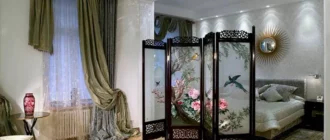
Bionic style in the interior – a synthesis of nature, high technology and art
The bionic style in the interior is a modern design direction, which is characterized by a simultaneous rapprochement with nature and a commitment to high technology. Bionics in the interior reflects the trends of recent years related to the environmental friendliness of space, the harmonization of all spheres of human life, the creation of comfortable conditions for creative activity and recreation.
The bionic style allows you to give the interiors of the premises an unusual, truly unique look, in which the images of the surrounding world are harmoniously integrated: the wings of a butterfly, the structure of a leaf, the structure of a living cell. Possessing individuality and originality, the style is suitable for extraordinary people: those who, in pursuit of light and space, are tired of standard, template solutions, who appreciate the natural presentability of the environment and are ready for bold experiments.


The main characteristics and features
The bionic style in the interior is based on the concept of the perfection of natural forms. Its main feature is a close connection with nature, its structure, structure, diversity of species. But, as it was established by the expressionists, direct copying of natural forms does not bring a positive result, it is often difficult or even impossible. Therefore, bionic design is based on the analysis of the natural form, the definition of its tectonics and the creation of a symbolic image. Such a transformation, thanks to modern technologies, allows you to transfer the aesthetics of natural creations into interiors and create harmonious spaces.

Like living nature, which does not have clear lines, bionics has abandoned the division of space into zones. Ideally, all parts of the room form a single whole, the apartment turns into a spacious studio, and a country house, like a grotto or a cave, becomes a continuation of the landscape. If necessary, non-standard techniques are used for zoning with smooth transitions that create the illusion of movement.

The main characteristics of the bionic style in the interior include:
- Form. Preference is given to light, complex and at the same time airy structures.
- Color. Differs in moderation, limited palette, lack of monotony. White color is often combined with light shades of green, gray, brown. Even the visually striking design, as if shrouded in a light smoky veil, does not look intrusive.
- Materials. The latest construction technologies help to realize the most daring ideas in the interior, to create durable and lightweight non-standard structures. Innovative metal alloys, composites, polymers are used. A combination of any structures is appropriate, for example, glass, raw stone and natural leather. Non-fading and tactilely pleasant fabrics are used that imitate the morphology of representatives of flora and fauna.
- Lighting. The design requires a lot of light to emphasize shapes and spaces. Sometimes directional artificial lighting is used to place accents on individual interior details.


The history of the bionic style in the interior
In the history of design, there are many examples of appeal to natural forms. However, the concept of bionics as an interior style that reflects the connection with the outside world appeared only in the second half of the 20th century.
The term itself refers to 1958. American scientist Jack Steele used it to denote the principle of “learning from nature” through the study of living systems by analytical methods.


Gradually, bionics began to penetrate into various sciences and formed as an independent design direction. The closest to it in appearance were: futurism; minimalism; high tech.
Bionics in the interior is an outstanding design method that has moved away from the usual standard solutions, has made it possible to create modern spaces with functional thoughtfulness, maximum comfort and the inexpressible beauty of natural forms, elevated them to the same level as art and sculptural art.
















